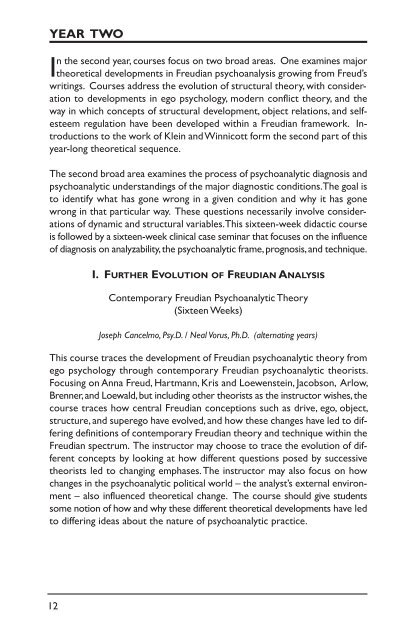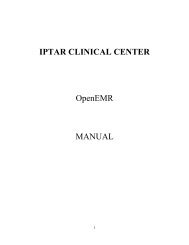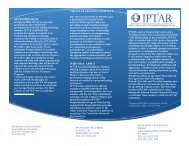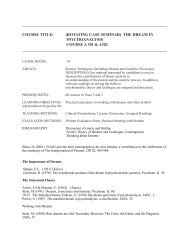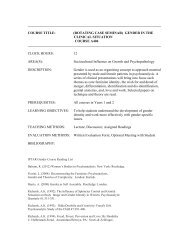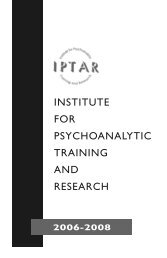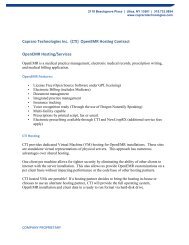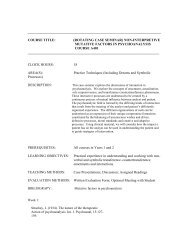IPTAR Bulletin - Institute for Psychoanalytic Training and Research
IPTAR Bulletin - Institute for Psychoanalytic Training and Research
IPTAR Bulletin - Institute for Psychoanalytic Training and Research
You also want an ePaper? Increase the reach of your titles
YUMPU automatically turns print PDFs into web optimized ePapers that Google loves.
YEAR TWO<br />
In the second year, courses focus on two broad areas. One examines major<br />
theoretical developments in Freudian psychoanalysis growing from Freud’s<br />
writings. Courses address the evolution of structural theory, with consideration<br />
to developments in ego psychology, modern conflict theory, <strong>and</strong> the<br />
way in which concepts of structural development, object relations, <strong>and</strong> selfesteem<br />
regulation have been developed within a Freudian framework. Introductions<br />
to the work of Klein <strong>and</strong>Winnicott <strong>for</strong>m the second part of this<br />
year-long theoretical sequence.<br />
The second broad area examines the process of psychoanalytic diagnosis <strong>and</strong><br />
psychoanalytic underst<strong>and</strong>ings of the major diagnostic conditions.The goal is<br />
to identify what has gone wrong in a given condition <strong>and</strong> why it has gone<br />
wrong in that particular way. These questions necessarily involve considerations<br />
of dynamic <strong>and</strong> structural variables.This sixteen-week didactic course<br />
is followed by a sixteen-week clinical case seminar that focuses on the influence<br />
of diagnosis on analyzability,the psychoanalytic frame,prognosis,<strong>and</strong> technique.<br />
12<br />
I. FURTHER EVOLUTION OF FREUDIAN ANALYSIS<br />
Contemporary Freudian <strong>Psychoanalytic</strong> Theory<br />
(Sixteen Weeks)<br />
Joseph Cancelmo, Psy.D. / Neal Vorus, Ph.D. (alternating years)<br />
This course traces the development of Freudian psychoanalytic theory from<br />
ego psychology through contemporary Freudian psychoanalytic theorists.<br />
Focusing on Anna Freud, Hartmann, Kris <strong>and</strong> Loewenstein, Jacobson, Arlow,<br />
Brenner,<strong>and</strong> Loewald,but including other theorists as the instructor wishes,the<br />
course traces how central Freudian conceptions such as drive, ego, object,<br />
structure, <strong>and</strong> superego have evolved, <strong>and</strong> how these changes have led to differing<br />
definitions of contemporary Freudian theory <strong>and</strong> technique within the<br />
Freudian spectrum. The instructor may choose to trace the evolution of different<br />
concepts by looking at how different questions posed by successive<br />
theorists led to changing emphases.The instructor may also focus on how<br />
changes in the psychoanalytic political world – the analyst’s external environment<br />
– also influenced theoretical change. The course should give students<br />
some notion of how <strong>and</strong> why these different theoretical developments have led<br />
to differing ideas about the nature of psychoanalytic practice.<br />
Klein <strong>and</strong> the Neo-Kleinians<br />
(Eight Weeks)<br />
Monica Carsky, Ph.D. / Karen Komisar Proner, M.S. (alternating years)<br />
This seminar will focus on Melanie Klein's seminal papers. It will look at how<br />
Klein's ideas developed from Freud's theoretical thinking, in particular his<br />
later papers, <strong>and</strong> from Abraham's theoretical explorations on early stages of<br />
libidinal organization <strong>and</strong> object relations. Concepts considered are: the<br />
establishment of early object relations, the pre-stages of oedipal conflict <strong>and</strong><br />
superego <strong>for</strong>mation, <strong>and</strong> Klein's theory of the paranoid-schizoid <strong>and</strong> depressive<br />
positions. The latter are essential to an underst<strong>and</strong>ing of Klein's ideas<br />
about psychotic anxieties, unconscious fantasy, <strong>and</strong> the interrelation between<br />
internal <strong>and</strong> external reality.<br />
Winnicott <strong>and</strong> the Middle Group<br />
(Eight Weeks)<br />
Naama Kushnir-Barash, Ph.D. / Corliss Parker, Ph.D.(alternating years)<br />
The work of D.W. Winnicott <strong>and</strong> various members of the Middle Group will be<br />
discussed. Winnicott’s theoretical <strong>and</strong> clinical papers will be the primary focus.<br />
His ideas about early development including children’s emerging capacities to<br />
symbolize, to play, <strong>and</strong> to experience increasingly more complex states of differentiation,<br />
relatedness, <strong>and</strong> aloneness will be examined. In addition, papers<br />
on true/false self, transitional phenomena, <strong>and</strong> aspects of the psychoanalytic<br />
situation including regression,transference,<strong>and</strong> countertransference phenomena,<br />
will be studied.<br />
II. DIAGNOSIS AND ANALYZABILITY IN THE<br />
PSYCHOANALYTIC SITUATION<br />
<strong>Psychoanalytic</strong> Diagnosis I <strong>and</strong> II<br />
(Sixteen Weeks)<br />
Marvin Hurvich, Ph.D. / Seymour Moscovitz, Ph.D.(alternating years)<br />
This course presents a psychoanalytic approach to diagnosis that details<br />
differences between levels of psychic structure. Neurotic, narcissistic, borderline,<br />
<strong>and</strong> psychotic organizations are examined with regard to ego <strong>and</strong> superego<br />
functioning, drive-defense conflicts, deficits, <strong>and</strong> adaptive implications<br />
unique to each. These differences are highlighted by a delineation of symptom<br />
<strong>for</strong>mation at the various structural levels. Differences between sub-groupings<br />
within psychotic, borderline, <strong>and</strong> neurotic ranges are considered.<br />
13


